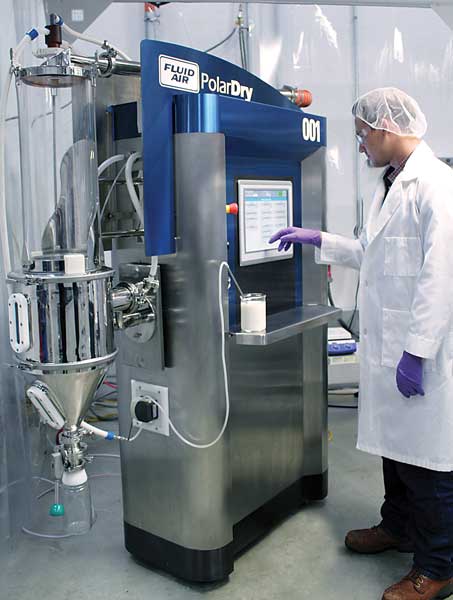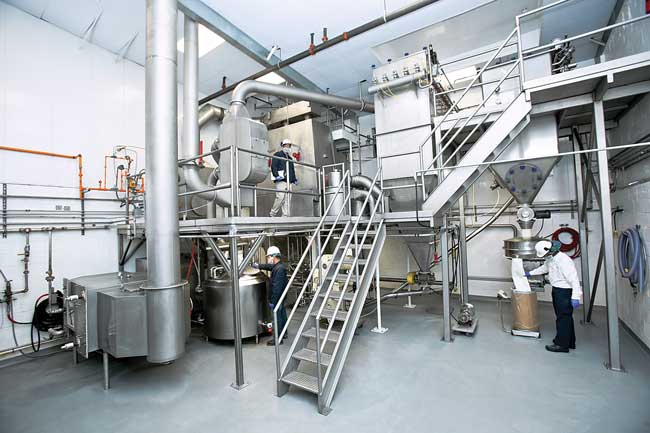The Significance of Spray-Drying
PROCESSING
Spray-drying is the transformation of a pumpable feed from a fluid state into a dried particulate form by spraying the feed into a hot drying medium (Anandharamakrishnan and Ishwarya 2015). The history and market for this technology will be reviewed, as will the process details. Applications will also be discussed in this month’s Processing column.
History and Market
Spray-drying was invented by Samuel Percy in 1872. World War II resulted in widespread implementation of spray-drying. The dairy industry used it to produce milk powder for the military. Since then, many improvements have been made. These have enabled the technology to produce high quality, free-flowing powders from a wide range of materials, including foods, pharmaceuticals, soaps, fertilizers, clays, and other products.
The food industry accounts for the largest market share of spray-drying equipment. According to Technavio, the food spray-drying equipment market was valued at $1.2 billion in 2016 and is projected to increase to $1.5 billion by 2021. The largest market for spray-drying equipment is for milk products and was valued at $420 million in 2016. Single-fluid nozzle atomizers account for the largest market share, amounting to 45%. Two-stage spray-dryers are the fastest-growing and have the largest market share at 40%. Co-current flow spray-dryers also dominate the food market. North America dominates the global spray-drying equipment market, and Asia-Pacific is the fastest-growing market. The global spray-dried food market is predicted to grow at 4.2% a year during the next five years.
Benefits of Spray-Drying
Some of the advantages of spray-drying include its ability to be fully automated and continuous. Short residence times and suitability for both heat-sensitive and heat-resistant foods are other advantages. The technology is suitable for a variety of feed materials, provided they are pumpable. It enables ingredient suppliers to tailor the functionality of their food ingredients. Control over final product dispersibility in solution is obtainable, as is modification of final product color. Finally, the ability of spray-drying to form a wide range of unique particle morphologies is appealing.
Spray-drying is often used for encapsulation. Active substances can be homogenized into emulsions or slurries prior to spray-drying and dried into functional ingredients. Encapsulation has many advantages, two of which are protection against thermal degradation and improved final product functionality. It is important to note that spray-dried materials are not fully encapsulated.
Spray-Drying Processing Equipment
Spray dryers consist of a few basic elements: air filter, intake fan, heat source, feed source, feed pump, atomizer, drying chamber, cyclone separator, bag filter and/or electrostatic precipitator, and exhaust fan. Air is drawn through a filter into a spray-dryer using a fan. The filter not only prevents contamination of the product, it also removes particles that could possibly ignite. The air is heated through direct or indirect heating. The feed source tank may be heated to lower the product viscosity prior to spray-drying. Peristaltic, piston, and progressive cavity pumps can be used to feed the spray-dryer.
The atomizer is responsible for dividing the feed solution into individual droplets. It strongly influences the final shape, structure, velocity, and size of the droplets, as well the particle size distribution and nature of the final product. The two major types of atomizers are rotary atomizers and nozzle atomizers. Rotary atomizers are driven by high- velocity liquid discharge from the edge of a disc. The spinning disc utilizes the shearing action of air at the outer edge of the disc to break the liquid feed into a spray that leaves the disc in the horizontal direction. Rotary atomizers produce fine to coarse droplets, ranging from 30–120 µm. They are generally more expensive than nozzle atomizers but do not clog and can produce uniformly sized droplets. The main disadvantages of rotary atomizers are that they are limited in their ability to handle viscous feeds and cannot be used with short-form spray-dryers.
 Nozzle atomizers discharge feed liquids under pressure through an orifice as a high-speed stream that breaks into a spray of droplets. Operating pressures range from 250–10,000 psi. Single-nozzle atomizers produce coarser and less homogeneous sprays than rotary atomizers and produce droplet ranges from 120–250 µm. They are best suited to process low-viscosity feeds. Two-fluid nozzle atomizers pump liquid through an inner orifice that is surrounded by an outer orifice through which a high-velocity air or other gaseous stream flows. The feed is atomized into droplets due to the impact of high-velocity air or other gas around it. Two-fluid nozzle atomizers produce a smaller droplet range of 30–150 µm. They can process high viscosity feeds and produce finer, more homogeneous droplet size distributions. One disadvantage is cost. Ultrasonic atomizers use an electromechanical device that vibrates at a high frequency to disrupt the surface tension of the liquid and cause droplet formation. Advantages include more uniform particle size distributions, higher retention of active compounds, and less clogging. Electro-hydrodynamic atomizers create electrosprays using electrostatic charging. Application of a high-intensity electric current between two oppositely charged electrodes enables production of droplets with narrow particle size distributions. Spraying Systems Co. utilizes electrostatic technology to dry particles at lower operating temperatures, reducing heat degradation of active components and allowing for greater encapsulation efficiency of highly volatile compounds.
Nozzle atomizers discharge feed liquids under pressure through an orifice as a high-speed stream that breaks into a spray of droplets. Operating pressures range from 250–10,000 psi. Single-nozzle atomizers produce coarser and less homogeneous sprays than rotary atomizers and produce droplet ranges from 120–250 µm. They are best suited to process low-viscosity feeds. Two-fluid nozzle atomizers pump liquid through an inner orifice that is surrounded by an outer orifice through which a high-velocity air or other gaseous stream flows. The feed is atomized into droplets due to the impact of high-velocity air or other gas around it. Two-fluid nozzle atomizers produce a smaller droplet range of 30–150 µm. They can process high viscosity feeds and produce finer, more homogeneous droplet size distributions. One disadvantage is cost. Ultrasonic atomizers use an electromechanical device that vibrates at a high frequency to disrupt the surface tension of the liquid and cause droplet formation. Advantages include more uniform particle size distributions, higher retention of active compounds, and less clogging. Electro-hydrodynamic atomizers create electrosprays using electrostatic charging. Application of a high-intensity electric current between two oppositely charged electrodes enables production of droplets with narrow particle size distributions. Spraying Systems Co. utilizes electrostatic technology to dry particles at lower operating temperatures, reducing heat degradation of active components and allowing for greater encapsulation efficiency of highly volatile compounds.
Drying chambers are constructed in a range of designs. Their volume is determined by the required heat exposure time. On initial contact, a hard outer surface is formed. As the particle falls down the chamber, the inner liquid is drawn out of the particle and subsequently dried by the hot air in the chamber. Hot air dries droplets in co-current, counter-current, or mixed flow within the chamber. In co-current flow drying, the contact with the hot air is only a few seconds, resulting in the advantages of lower-temperature drying and less thermal degradation. This is the most common type of drying.
The primary separation of product from air is generally located at the base of the conical spray-drying chamber, followed by removal using a screw conveyor or pneumatic system with a secondary separator. Cyclone separators, bag filters, and electrostatic precipitators are then used to recover the final product. The most commonly used separator is the cyclone, due to its ease of cleaning and low cost. Powder enters the cyclone tangentially, and air and powder spin down the length of the cyclone wall. Concurrently, air is pulled upwards inside the chamber. A dead zone is created, and the powder is pulled from the dead zone. Over 99% collection efficiency is possible. A bag filter may be used with or without the cyclone. Bag filters work by pulling air through the bag filter using an exhaust fan and then collecting the powder in the bag. Bag filters have very high efficiencies and meet emission regulations. Electrostatic precipitators collect particles using electrostatic force. Finally, exhaust fans are used to draw air from the chamber.
Spray-dryers are classified as open cycle, closed cycle, and semi-closed cycle based on whether the heating medium is recycled. Open-cycle dryers convey the air through once. Closed-cycle dryers recycle the drying medium, which in this case is usually not air but nitrogen or another inert gas. Closed dryers are used in conjunction with flammable solvents and products that are highly susceptible to oxidation.
Single-stage spray-dryers have higher outlet temperatures than two-stage spray-dryers and are not suitable for heat-sensitive products. They also result in increased likelihood of powders sticking together. Finally, spray-dryers can be short-form, with a height to diameter ratio of 2:1, or tall-form, with height to diameter ratios of greater than 5:1.
Often both upstream and downstream processes are incorporated into the overall spray-drying process in order to reduce costs. For example, evaporation technologies may be used on the feed stream prior to spray-drying to raise the feed solids. Fluidized bed technology may be employed for final drying following spray-drying to allow higher-moisture material to exit the spray-dryer.
 Equipment Manufacturers and Copackers
Equipment Manufacturers and Copackers
Equipment manufacturers include GEA Group, SPX Flow Technology, Buchi Labortechnik, Fluid Air Division of Spraying Systems Co., Dedert Corp., European Spray Dry Technologies, Changzhou Lemar Drying Engineering, New AVM Systech, C.E. Rogers Co., and others.
Copacking plants include Watson, Pacmoore Products, American Custom Drying Co., and others.
Commercial Applications
Some common applications of spray-drying in food processing include conversion of fruit and vegetable juices into instant powders and mixes, preparation of instant coffees and teas, drying of eggs and dairy products, ice cream mixes, and encapsulated flavors and bioactive nutraceuticals.
Future Opportunities
Recent advances include development of a novel, no heat spray-drying technology by ZoomEssence. This technology provides an energy-efficient alternative to heat-based spray-drying methods that may degrade certain high-value products. Scale-up of this process is currently underway, and one application is for food flavors. Other recent developments include the ability to form nano-sized powders with unique properties and the use of superheated steam drying to sterilize products while spray-drying.
 Tara McHugh, PhD, Contributing Editor
Tara McHugh, PhD, Contributing Editor
Research Leader, USDA Agricultural Research Service, Albany, Calif.
[email protected]
References
Anandharamakrishnan, C. and Padma Ishwarya S. 2015. Spray-drying for Food Ingredient Encapsulation, first edition, John Wiley & Sons.


